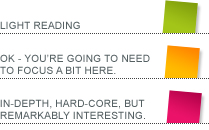This is an introduction to email marketing and what your options are, for marketers & business owners – earlier we wrote about designing for email but here we’ll keep to an overview of what email marketing is and what tools you need to do it effectively.
Email marketing can cover monthly newsletters sent via email; discount coupons sent to customers; or invitations to events. All of these are specially prepared communications, sent to a mailing list.
Why Email Marketing?
The simple reason email marketing works is that people don’t visit your website every morning, but they do open their email every morning, and, if they’re so inclined and have a BlackBerry, they open it 24/7. This means that if you communicate with your customers via email you have a greater chance of them reading your message.
Email Marketing is also perfect for rounding out a promotion or brand campaign. When used in conjunction with an in-store promo it can be particularly effective.
There are 3 key aspects to email marketing
1: Mailing Lists
You will need to send your email marketing campaigns to a mailing list – a database of customers, potential customers, clients and suppliers. Your mailing list can become a very valuable tool if it is large and well targeted.
Spam
Making sure you don’t send people spam is a legal requirement – the Consumer Protection Act, No 68 of 2008 came into force in 2011. More importantly it is good marketing – if you send communications to a receptive audience you’re more likely to ultimately to get a sale than if you send to an unwilling audience. If you spam people they will not buy from you – not now and not in the future.
Very basically, if you didn’t receive explicit permission from someone to send them marketing information, it is spam.
You can send marketing emails to the following people:
- People who signed up via a “Subscribe to our mailing list” form, either online or offline
- Someone you have met who gave you their verbal permission to send them marketing information
- Existing customers who you have emailed in the last year or so
Here’s a great article from Campaign Monitor on some email permissions FAQs.
Managing subscriber lists
You’ll need a system to manage your subscriber list. Later we’ll look at some options, but the main points are:
- You need to be able to import existing mailing lists
- You need to be able to have segmented lists – so you speak to potential clients differently to existing clients
- Unsubscribes need to be automatically handled
- The list should tie in with an online “Join our list” form
2: Creating HTML email marketing campaigns
Think of it this way: If you were to create a brochure to distribute, you would contact a designer, and get it printed. When you prepare an email marketing campaign, you need to design it similarly, and publish it.
For email, this is done by creating an HTML formatted email and sending it to Outlook, Gmail or another email client. What does HTML formatting mean? Look at a web page – it is in HTML, which means the text, images and links are coded so that a web browser (like Internet Explorer) can show them to you in the right layout and style. Email works in a similar way: An HTML formatted email can contain text, images and links, formatted and styled in a specific way – to match you brand identity or your logo.
In addition, many good bulk email services allow you to use HTML templates – which means you can use the same design over and over again, and simply change the text, images and links for each different email campaign.
3: Getting reports on your marketing campaign
Very simply a marketing campaign is useless if you have no way of measuring its success. Bulk Email servers have the ability to send many individual emails at once (as opposed to one email CC’d to many people). Because of this, they can get feedback on how many people opened the email, if the email bounced, what links people clicked and who unsubscribed from the mailing list.
These reports allow you to keep your mailing list clean, and to adjust your campaigns (for example how they are worded, or when they are sent) for greater effectiveness.
If you’re selling advertising space on your emails, reports allow you base ad value on readership and clicks.
- Reports showing number of emails opened, bounced emails and unsubscribes.
Choosing an email marketing service
We’re going to look at the options in more detail in another post. For now we recommend looking at Campaign Monitor – especially their blog , which is the best way to educate yourself about email marketing that we have found.





